How to clean the heating element of a washing machine
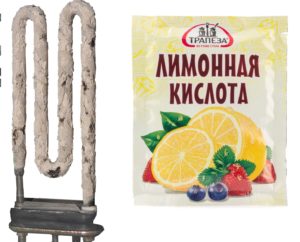 The heating element of a washing machine is a very important, but at the same time a very vulnerable part. Located quite close to the rotating drum of an automatic washing machine, it slowly but surely becomes covered with layers of lime deposits due to the hardness of the water. If the heating element is not cleaned, then over time the layer of scale will become so thick that it will begin to come into contact with the walls of the drum. Once this happens (unless the part burns out first), failure is inevitable. Read about how to clean the heating element from scale in this publication.
The heating element of a washing machine is a very important, but at the same time a very vulnerable part. Located quite close to the rotating drum of an automatic washing machine, it slowly but surely becomes covered with layers of lime deposits due to the hardness of the water. If the heating element is not cleaned, then over time the layer of scale will become so thick that it will begin to come into contact with the walls of the drum. Once this happens (unless the part burns out first), failure is inevitable. Read about how to clean the heating element from scale in this publication.
Cleaning products
There are many means with which, according to the manufacturer, you can clean the heating element, but not all of these means are equally effective. Moreover, the success of the business largely depends on the chosen method of cleaning the heating element. But let's not get ahead of ourselves. The main means with which housewives try to clean the heating elements of their “home assistants” is citric acid. By the way, this remedy is not bad, but it is far from the only one. You can see a lot of industrial chemicals in the store.
There are many products on the market for cleaning the heating element of a washing machine, and all of them are more expensive than regular citric acid.
- Top House;
- Topper;
- Magic Power;
- Zool;
- Frau Schmidt and others.
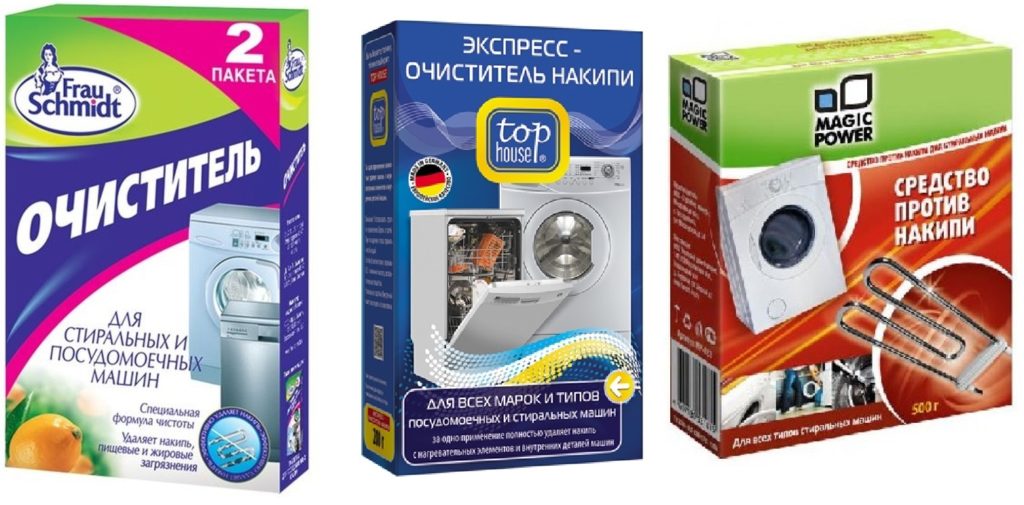
The principle of operation of the above products is the same, cleaning using active chemicals. They actively dissolve scale deposited on the heating element, gradually cleaning the heating element, and at the same time other parts of the machine from lime deposits. True, there is one “but”. Many commercial descaling products contain citric acid.The question arises, why overpay for an expensive foreign product when you can take an ordinary cheap lemon juice and the cleaning effect will be the same? The answer, in our opinion, is obvious. And for experienced housewives, cleaning with lemon has always been a priority.
Some housewives sincerely believe in the miraculous properties of the well-known, thanks to aggressive advertising, Calgon powder. It is used both to prevent the formation of limescale and to clean the heating element of the washing machine. How justified is this?
Yes, this is in no way justified! Firstly, Kalgon is not intended for cleaning the heating element of a washing machine from limescale, and this is determined by the manufacturer itself. Cleaning with Calgon is doomed to failure. Secondly, Calgon is not even able to soften the water sufficiently so that scale does not settle on the heating element. Our independent tests showed that in those washing machines where Calgon was used, scale also formed and coated the heating element, although a little more slowly. In the end, you will spend many times more money on Calgon than you will later on repairs and replacement parts, although, of course, it’s up to you to decide.
Calgonite and products similar in composition to Calgon are also considered ineffective. In total, a lot of money is spent on them, but there is very little benefit from it.
When there is little limescale
If you have never cleaned the heating element of your washing machine from scale, but your washing machine is new, you can safely use the chemical cleaning method without dismantling the heating element. To do this you need to perform a number of simple steps.
 To clean the scale from the heating element of the machine, take 100 g of citric acid and pour it into powder tray. You need to pour it into the main wash compartment.
To clean the scale from the heating element of the machine, take 100 g of citric acid and pour it into powder tray. You need to pour it into the main wash compartment.- Close the tray, remove everything that is there from the hatch of the washing machine, first of all the dirty laundry.
- Set the washing program for at least 1.5 hours at a temperature of at least 600C, the lower the temperature, the slower the reaction, so in our opinion it is better to set 90-950WITH.
- Wait for the program to complete and that’s it, you can not repeat cleaning with citric acid for 3-4 months, the heating element will be fine.
A small amount of lemon scale can be cleaned without problems. But here it is important to repeat the procedures at least once every 3-4 months. Even if you think that you have soft water and the heating element “does not suffer,” still carry out the above procedure - you will not regret it.
When the washing machine heater is overgrown with scale
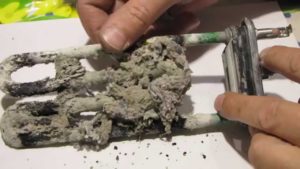 You can clean a small amount of scale from the heating element using lemon juice or other safe chemicals, but what to do if you suspect that the heating element is actually overgrown with plaque. In this case, dry cleaning of the washing machine cannot be used.
You can clean a small amount of scale from the heating element using lemon juice or other safe chemicals, but what to do if you suspect that the heating element is actually overgrown with plaque. In this case, dry cleaning of the washing machine cannot be used.
The fact is that chemical cleaning in this case can end badly both for the spare part itself and for the washing machine as a whole. When using lemon juice, pieces of water stone will begin to fall off the heating element and fall into the pipes or remain in the tank, risking blocking the rotation of the drum and contaminating the clothes being washed. In general, such cleaning will do more harm than good, but what can you do, how can you clean the part in this case without harming the washing machine?
Large pieces of scale can hang around in the machine for hundreds of washes and cause harm to the “home assistant”, causing it to break down.
There is only one way out - to clean the heating element by first removing it from the washing machine.In this case, difficulties may arise, because not everyone can decide to disassemble a washing machine before it breaks down, and even then. Not everyone will be able to independently remove this part from the washing machine, although in our opinion it is not at all difficult. We understand the fears and uncertainty of automatic washing machine users, but it is also clear to us that if the heating element is not removed and cleaned now, then in a month or two it may simply burn out and then repairs will have to be carried out at additional costs. What are we doing?
- We determine the location of the heating element in your washing machine model. The easiest way is to remove the heating element from a top-loading washing machine, because in such models it is removed through the service hatch located inside the drum. For front-facing cameras, the heating element can be located either behind the front wall of the case or behind the rear.
- We remove the heating element from the washing machine. We have already written several times about how to remove the heating element from a washing machine in order to check or replace it in various publications on our website, so we will not repeat it. If you are interested in details, you can read the article Replacing the heating element in a Bosch washing machine.
- We take the part that is overgrown with limescale and rinse it under running hot water, while at the same time we try to clean off the pieces of scale with our fingers.
Under no circumstances try to remove plaque with sandpaper, a wire brush, or even scrape it off with a knife. It's so easy to damage a part and cause problems.
- When we manage to clean the heating element, freeing it from large pieces of scale, we take a two-liter plastic bottle, cut off the top part from it, take 3-4 tablespoons of citric acid along with the neck and pour it into this container. Pour hot water into the container, stir the lemon, and then put the part in the container.
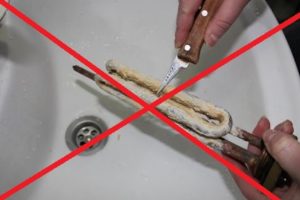 Now we just have to wait about a day. During this time, a concentrated solution of lemon juice will dissolve the remaining scale from the heating element, and the part will shine like new again. We rinse the part under running water, wipe it with a cloth and you can put the heating element back in place. It is done.
Now we just have to wait about a day. During this time, a concentrated solution of lemon juice will dissolve the remaining scale from the heating element, and the part will shine like new again. We rinse the part under running water, wipe it with a cloth and you can put the heating element back in place. It is done.
Cleaning the heating element of an automatic washing machine is not difficult, especially if you do not allow the heating element to become excessively overgrown with water stone. If this does happen, you will have to remove and clean our part manually, otherwise the heater will simply burn out. Good luck!
Interesting:
2 reader comments



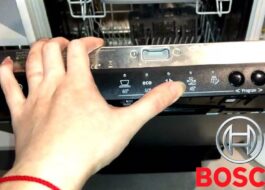


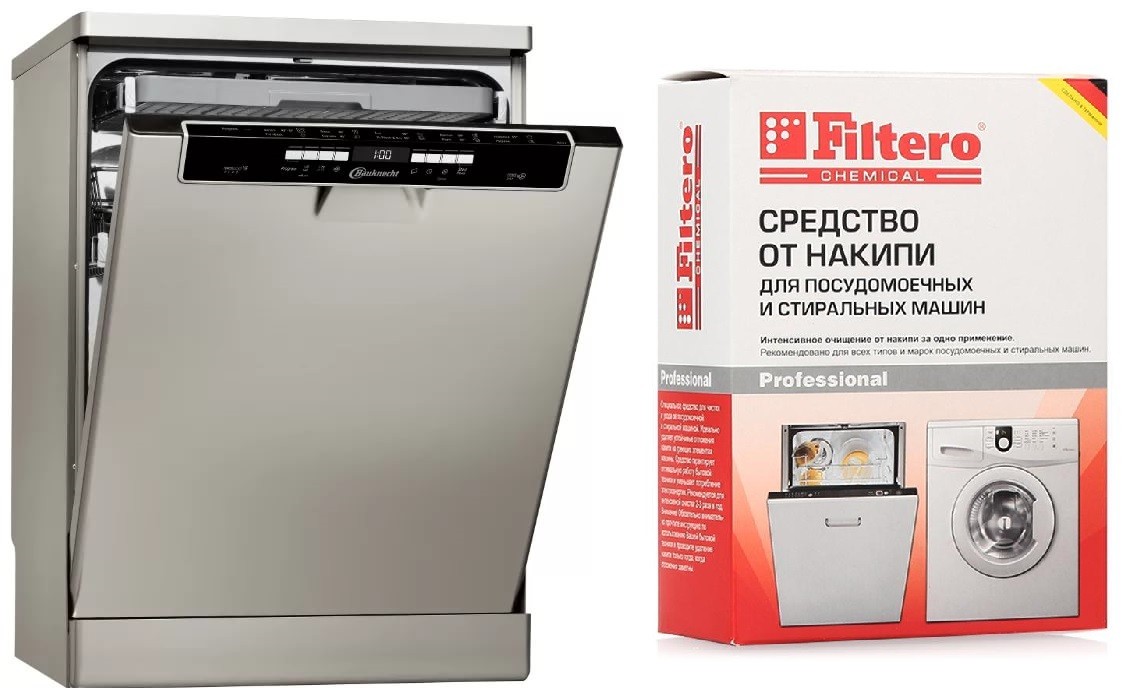














Simple, accessible and understandable.
But they didn’t say how to put back a heating element with a worn rubber band :)